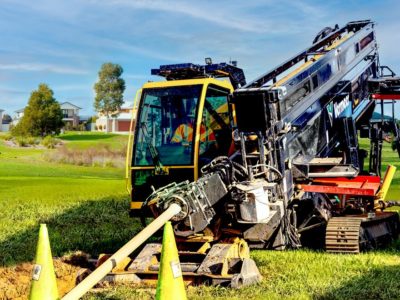Efficiency is a major factor for the success of a long-term pipeline job. On the other hand, basic cost may be the biggest variable underlying the viability of a smaller, quicker fiberoptic line installation, for example.
Differences like these — as well as the virtually endless combinations of equipment common on the range of horizontal directional drill (HDD) jobsites dealers are responsible for servicing and maintaining — create a lot of diversity in each dealer’s responsibilities, especially when it comes to specific components like downhole tooling. Providing the highest level of service to contractors takes attention to these types of variables, and in a territory like John Fiddler’s, that means a lot of windshield time. The HDD tooling sales representative with Vermeer Texas-Louisiana, based in Irving, Texas, works with HDD contractors in north and central Texas to keep jobs running smoothly regardless of the size or color of their equipment.
“We work with a lot of mixed fleets, both Vermeer and competitive equipment. They’re working on different HDD jobs, both utility and pipeline,” Fiddler said. “The type of HDD work they’re doing and their location dictate what kind of tooling they’ll need.”
Work toward specific goals
Identifying those needs typically has dealers like Fiddler on the road often, traveling to customer jobsites. But he doesn’t consider himself a salesperson. He’s learned over time that the acknowledgement of shared goals is both how to start the conversation he has with each HDD contractor, as well as the most direct path to the solutions they need.
“Every contractor I see on the road, I approach it with the goal in mind to add value to his or her jobsite,” Fiddler said. “I’m not trying to sell them something; I’m looking at what’s going on during that job, what they have to get done and how I can help them. Sometimes, it’s about productivity, but other times it’s more about efficiency. However, if I can add value to their jobsite, that’s my goal.”
Reaching that goal is different on each HDD jobsite, and nowhere is that more exemplified than in the tooling Fiddler provides his customers. Though various Vermeer tooling is compatible with other manufacturers’ HDD drills, there’s more to the purchasing decision than which tooling will work best for each job. It’s important to account for the progress of a job, the operators running the machines and what is the highest priority for the contractor managing his or her crew.
Consider these tooling purchasing design factors
Fiddler recommends considering these factors when making HDD tooling purchasing decisions:
- Top priorities: Time, efficiency, etc.
- Machinery on the jobsite: Manufacturers, machine size, etc.
- Primary market: Utility, pipeline or other industry sector.
- Operation size: Number of work crews, jobsites and machines.
- Maintenance over time: Equipment service and expectations from manufacturers.
- Future job expectations: How far in advance do you plan future jobs?
“Tooling is obviously an expense, and a lot of times, a contractor wants to know that it is going to help them solve problems. If I can offer value by talking through the issues they’re having and giving them insights on how they can become more productive in the future, we can create a common ground and they can determine which specific tooling is going to help them meet their objectives. We are always planning and talking to customers to try to find out what they have laid out in the future so we can be proactive and prepared,” Fiddler said. “First, find out what’s important to each customer and become more of a support role. It’s all about earning trust.”
Determine the right priorities
Establishing that relationship is about more than identifying needs and required solutions. It’s also important to know who specifically you’re talking to when starting the tooling conversation on the jobsite. What’s valuable to a company owner, for example, may not be shared by a machine operator. Determining which of those priorities top the list is a major step in providing the right tooling for each job.
“If you’re talking to an operator, he or she is going to want something that’s convenient. An owner is going to want the most efficient tooling,” Fiddler said. “I’m not there to just sell them tooling. I’m there to make sure things are efficient for them.”
For more information, contact your local Vermeer dealer today.
Vermeer Corporation reserves the right to make changes in product engineering, design and specifications; add improvements; or discontinue manufacturing or distribution at any time without notice or obligation. Equipment shown is for illustrative purposes only and may display optional accessories or components specific to their global region. Please contact your local Vermeer dealer for more information on machine specifications.
Vermeer and the Vermeer logo are trademarks of Vermeer Manufacturing Company in the U.S. and/or other countries. © 2022 Vermeer Corporation. All Rights Reserved.
